California Livin’
Posted on June 3, 2010 – 8:00 AM | by OldManFoster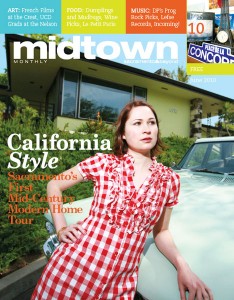 By Tim Foster photos by Scott Duncan
By Tim Foster photos by Scott Duncan
While Sacramento is rightfully known for the plentiful Victorians, Queen Annes and Craftsman bungalows that fill many neighborhoods, a growing group of design enthusiasts are now exploring an aspect of our architectural heritage that has long been ignored: Sacramento’s Mid-Century Modern. Inspired by their love for postwar modern design, Gretchen Steinberg and Kris Lannin Liang are leading the charge to protect, promote and preserve Mid-Century Modern art, architecture and design in the Sacramento region.
To that end, the pair are heading up Sacramento’s first Mid-Century Modern Home Tour. Scheduled for Saturday, June 26, the tour will feature over twenty examples of Mid-Century Modern architecture built between 1945 and 1970, and participants will be welcomed into eleven exceptional homes in the Land Park and South Land Park neighborhoods. The tour will showcase the work of a wide variety of architects, builders and designers including Jones + Emmons, Joseph Eichler and Sacramento’s Carter Sparks. The event kicks off at the Sacramento Executive Airport with a Mid-Century themed car show, a series of displays focusing on Mid-Century design and showings of Scopitones – the sixties precursor to the music video.
Steinberg has been a Mid-Century Modern fan as long as she can remember. She grew up near Palm Springs, surrounded by Mid-Century architecture, and writes about modern design on her Eichlerific blog, She now owns a Mid Century Modern custom home and an Eichler, both in South Land Park. “Interest in modern waxes and wanes,” she says, “just like with fashion.” Liang, who moved to Sacramento in 2003, had owned a Mid-Century Modern home in southern California and couldn’t believe it when her Sacramento realtor didn’t know what she meant when she said she wanted to buy a Mid-Century Modern home.
“She didn’t know what I was talking about,” she says, laughing.
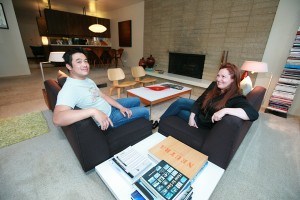 Mid-Century Modern, also known as Postwar Modern, is the successor to the first major modernist architecture movement, known as the International Style. Eager to create a domestic architecture for the Machine Age, International Style architects turned to factories and industrial buildings for inspiration. Architects like Germany’s Walter Gropius promoted buildings as ‘machines for living’ and focused on the goal of creating a universal architecture for the everyman. While Mid-Century Modernism shares many common traits with the earlier style (notably flat roofs, stark facades and the open floorplan) MCM design tends to be more playful, more colorful and decidedly more experimental – in short, more fun.
Mid-Century Modern, also known as Postwar Modern, is the successor to the first major modernist architecture movement, known as the International Style. Eager to create a domestic architecture for the Machine Age, International Style architects turned to factories and industrial buildings for inspiration. Architects like Germany’s Walter Gropius promoted buildings as ‘machines for living’ and focused on the goal of creating a universal architecture for the everyman. While Mid-Century Modernism shares many common traits with the earlier style (notably flat roofs, stark facades and the open floorplan) MCM design tends to be more playful, more colorful and decidedly more experimental – in short, more fun.
California, always a magnet for the adventurous and eccentric, has long been at the forefront of Modern architecture. When modernist Austrian architect Rudolph Schindler arrived in Los Angeles in 1920, the modern architecture that would soon revolutionize European design was almost unknown in the United States. By the time the International Style had gained traction in the US, Schindler, along with friend and fellow architect Richard Neutra had already begun a shift away from ‘pure’ modernism to designs with a distinct California accent. Postwar West Coast architects and designers like John Lautner, Charles and Ray Eames and A. Quincy Jones expanded on Schindler and Neutra’s regional vocabulary and produced designs that epitomized the style that came to be known as Mid-Century Modern.
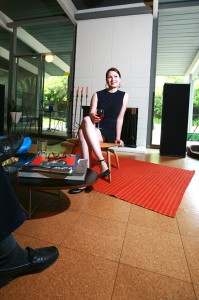 If the prewar International Style was a largely European movement, it can be argued that Mid-Century Modernism is peculiarly Californian. While MCM design has elements from around the world, notably Mies Van Der Rohe’s ultra clean German lines and glass walls, Frank Lloyd Wright’s Midwest marriage of the indoor and outdoor, and Oscar Niemeyer’s voluptuous Brazilian contours, it was in California that the successor to the International Style found its ultimate expression.
If the prewar International Style was a largely European movement, it can be argued that Mid-Century Modernism is peculiarly Californian. While MCM design has elements from around the world, notably Mies Van Der Rohe’s ultra clean German lines and glass walls, Frank Lloyd Wright’s Midwest marriage of the indoor and outdoor, and Oscar Niemeyer’s voluptuous Brazilian contours, it was in California that the successor to the International Style found its ultimate expression.
One reason for this was the concentration of new technologies in California – the war had seen tremendous advances in engineering, and much wartime industry had been based in the state, close to Pacific shipping. Climate played a role as well. Dramatic architectural designs that worked well in the temperate climate of California became possible to replicate in other parts of the country as Americans began to expect air conditioning and central heating in their homes. Perhaps an even bigger factor was the California attitude: an optimistic enthusiasm for the new that has marked emigrants to the state since the Gold Rush.
But probably the biggest reason of all was the postwar boom. California’s population more than doubled between 1940 and ’50, and then nearly doubled again between 1950 and 1960. That kind of growth meant jobs, taxes and plenty of new construction.
As California grew, so did Sacramento; the seat of state government, the city saw huge growth in the postwar period. By the mid fifties, wide swaths of the 19th and early 20th century buildings that then made up most of Downtown were being cleared to accommodate the growing government and business presence. Sleek multi-story office buildings replaced small commercial buildings and homes in the core. Almost invariably, the replacements followed a modernist style (See Bill Burg’s Midtown Moderne).
While modernism took hold in Downtown, it made only small inroads in the outer neighborhoods – at first. Commercial buildings and apartment blocks tended to be the first examples of Mid-Century Modern buildings introduced in the more suburban areas. Popularized by magazines like Sunset and Better Homes and Gardens, Mid-Century Modernism began to settle into the American mainstream. By the mid fifties, MCM homes were appearing in then-expanding Sacramento neighborhoods like South Land Park .
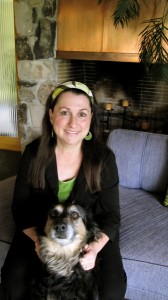 Though Steinberg and Liang live only a few minutes away from each other, they first met over the internet. Last year Liang discovered Steinberg’s Eichler blog and recognized a kindred spirit. The two soon met up at Mahoroba, a small coffee shop located in a funky modernist building on Freeport Blvd. The pair clicked immediately, so much so that Liang was encouraged to share a goal that she had been nursing for years: to organize a Mid Century Modern home tour in Sacramento.
Though Steinberg and Liang live only a few minutes away from each other, they first met over the internet. Last year Liang discovered Steinberg’s Eichler blog and recognized a kindred spirit. The two soon met up at Mahoroba, a small coffee shop located in a funky modernist building on Freeport Blvd. The pair clicked immediately, so much so that Liang was encouraged to share a goal that she had been nursing for years: to organize a Mid Century Modern home tour in Sacramento.
“[A] friend of mine… used to wind me up all the time and say I should do a home tour in our neighborhood, because I would point out homes, and I knew who built this one and that one, and I would go around knocking on people’s doors. When I discovered Gretchen’s blogspot….I thought, ‘there might be another person out there that would be interested in doing it with me.’”
Steinberg lives in a striking custom home designed by Ricky + Brooks, the same firm that designed the parabolas at the entrance to the Sacramento Zoo. Built for TB McCormack, a retired Walnut Grove pear farmer, the home was intended to be a showplace. “Mr. McCormack lived big, so this was a statement. I think he was very proud of this house,” she says. The home featured not only a modern design, but the latest electronic appointments, including a whole house music/intercom setup and solenoid electrical system so that he could control the lights from the bedroom. After she and her husband purchased the home in 2000 she dug into the history of the house, contacting McCormack’s family. Her diligence paid off when the family found the original architectural rendering in a shed – it now hangs prominently in the front room of Steinberg’s home.
Steinberg turned out to be the perfect partner for the tour project. While Liang knew about some of the homes in her neighborhood, she was stunned by the depth of Steinberg’s knowledge of Sacramento MCM. Calling herself an amateur ‘Urban Archaeologist’, Steinberg has spent hundreds of hours poring over old phone books, public records and microfilm of the Sacramento Bee and Union, carefully documenting the history of modernism in Sacramento, and posting many findings on her blog. As Liang and Steinberg began speaking to owners of the homes that they hoped to include on the tour, they often discovered that Steinberg knew more about a home’s history than the owners did.
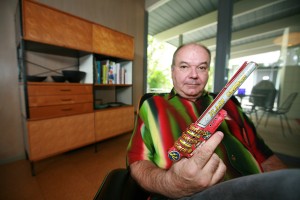 The first call they made was to Steinberg’s friend Dane Henas (and, full disclosure, a friend of mine as well), a Sacramento graphic designer who lives in a 1955 Eichler home, one of four Eichlers on the tour. Henas, who also collects iconic Mid-Century Modern furniture, has done a meticulous restoration, retaining most of the home’s original fixtures – including the original kitchen – replacing original elements only when they were missing or badly deteriorated. The result is about as close as one will find to what an Eichler would have looked like when Joseph Eichler sold it in 1955.
The first call they made was to Steinberg’s friend Dane Henas (and, full disclosure, a friend of mine as well), a Sacramento graphic designer who lives in a 1955 Eichler home, one of four Eichlers on the tour. Henas, who also collects iconic Mid-Century Modern furniture, has done a meticulous restoration, retaining most of the home’s original fixtures – including the original kitchen – replacing original elements only when they were missing or badly deteriorated. The result is about as close as one will find to what an Eichler would have looked like when Joseph Eichler sold it in 1955.
Bay area based builder Joseph Eichler became a fan of modern architecture when he briefly lived in one of Frank Lloyd Wright’s Usonian homes during World War II. Citing the experience of living in a modern architectural space as personally transformative, Eichler spent the rest of his life building and promoting modern homes. Eichler himself was not an architect. Instead, he hired some of the best of the then-current crop of modern architects like Robert Anshen, Raphael Soriano and A. Quincy Jones (who, with partner Frederick Emmons, provided the design for Dane Henas’ house) to design stylish suburban homes that could be built affordably for working families.
For many, Eichlers epitomize the Mid Century Modern home. Built with a post and beam design that eliminates the need for interior load-bearing structure, Eichlers feature walls of glass, exposed beams supporting a low slung or flat roof, radiant-heated floors, and many have a design element that became an Eichler trademark: an open-air atrium located inside the footprint of the house. None of the 60 Eichlers built in Sacramento featured an atrium, but many of the other 11,000 or so homes he built throughout California did. But if Eichler wouldn’t build atriums here (he is reputed to have thought the summers were too hot in Sacramento for them) there were others who would.
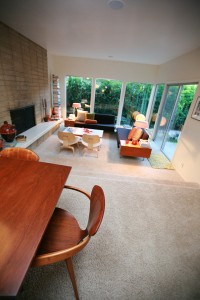 Sacramento architect Carter Sparks, is perhaps the preeminent name in Sacramento Mid-Century Modern. He is best known for his work for Sacramento builders Streng Brothers, who built around 3000 MCM homes based on his designs. Sparks also designed 50 or so stunning custom homes, two dramatic examples of which are on the tour. Sparks was known for inventive window placement and his extensive use of exposed natural wood, a preference that aligned him with other northern California modernists. An architect in the classic mold, Sparks raced sports cars, played tennis and skied, and fought against any dilution of his architectural ideals. And usually, he won. It was Sparks who designed a home that included an atrium for the Strengs; it became one of their most popular models, and examples exist in many neighborhoods in the Sacramento region today.
Sacramento architect Carter Sparks, is perhaps the preeminent name in Sacramento Mid-Century Modern. He is best known for his work for Sacramento builders Streng Brothers, who built around 3000 MCM homes based on his designs. Sparks also designed 50 or so stunning custom homes, two dramatic examples of which are on the tour. Sparks was known for inventive window placement and his extensive use of exposed natural wood, a preference that aligned him with other northern California modernists. An architect in the classic mold, Sparks raced sports cars, played tennis and skied, and fought against any dilution of his architectural ideals. And usually, he won. It was Sparks who designed a home that included an atrium for the Strengs; it became one of their most popular models, and examples exist in many neighborhoods in the Sacramento region today.
Eichler and Sparks may be the most familiar names on the tour, but there are outstanding examples of Sacramento Mid-Century Modern from other architects and designers as well. The design for Liang’s own home, a distinctive flat roofed MCM built largely of cinder blocks, was drawn up by GW Haggitt, She has learned that he was not an architect, but not much more. The daughter of a previous owner who confirmed that the unique house is largely original – right down to the barstools that came with the house.
Steinberg and Liang are floored by the reception their idea has received. If the project has perhaps been more work than they had expected, the response has more than made up for it. Ticket presales have been brisk, so much so, that they suddenly found themselves with a problem: what to do with the extra money? This time out they have partnered with the Short Center, but looking toward the future, the pair, along with Henas, have founded Sacramento Modern, a nonprofit organization that will seek to raise awareness of – and enthusiasm for – Sacramento’s Mid-Century Modernist gems.
While some still see modern architecture as strange or sterile, enthusiasts like Steinberg, Liang and Henas embrace it for the honesty of materials, strength of design and heady optimism it embodies. Liang has little time for skeptics. “We have movie parties in the carport and we LIVE in this house!” she says. “People might feel that these houses are cold, and angular and small, but in my opinion they’re intimate, and they’re inviting and they’re fun. They’re just fun.”
Sacramento Mid Century Modern Home Tour
Saturday, June 26, $20 advance / $25 day of
For more information on the Sacramento Mid-Century Modern Home Tour please go to http://sacmcmhometour.blogspot.com
Tags: Carter Sparks, Dane Henas, Eichler, Gretchen steinberg, Kris Lannin Liang, Sacramento Mid-Century Modern Home Tour



6 Responses to “California Livin’”
By IanMerk on Jun 6, 2010 | Reply
Any history of the mid-century modern style should include the Case Study House Program. The prototype designs in the program fundamentally changed the way we live, and their effect is most evident in the mid-century modern style.
By OldManFoster on Jun 6, 2010 | Reply
Definitely. the Case Study program was essential to the development of MCM. In a more extensive article I’d have delved into that history, but there was no way to do it justice in the few words I could have allotted- but that is one of the main reasons I mentioned Ray Eames- the Eames’ Case Study House is a true MCM classic, as are several of the other Case Study homes.
By Dion Neutra on Mar 30, 2011 | Reply
Could you help us spread the word about our upcoming event in Los Angeles?
85th ANNIVERSARY CELEBRATION PARTY
Join us to celebrate ‘Neutra Practice at 85 weekend’ April 8-10, 2011. Richard Neutra founded this firm in 1926 while he was still living in the Schindler House. Shortly thereafter, came the birth of his second son, Dion. At about this time, he was working on his first major project the Jardinette Apartments (1927) in Hollywood.. A couple of years later, the Lovell Health House (1929). After a distinguished 40 years, he joined his architect son, in as partner and vice president in 1965. Dion has carried on the firm since his father’s death in 1970, now himself for an additional 40 years. This is what we celebrate on this occasion. Join us!
For more info, visit http://neutra.org/reserve-your-space.html
For questions, please contact dion@neutra.org
Thank you in advance.